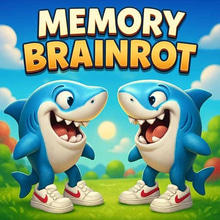???? Welcome to the Part of Your Brain You Shouldn't Visit
There’s something wrong with this puzzle. At first, it feels familiar. Like the memory games you used to play on cardboard mats in the living room — flip two tiles, try to match them, keep score. But here, in Brainrot Memory, each tile flips open something much deeper. Much darker. And if you’re not careful, it doesn’t just test your memory. It messes with it.
You’re not solving this puzzle to win. You’re solving it to survive.
????️ Everything Looks Slightly... Off
Images are blurry at first. Then too sharp.
Tiles that were in one spot are now somewhere else.
Some symbols repeat — others pretend to repeat.
The longer you play, the less you’re sure of what you saw — or when you saw it. But you keep flipping. Because something compels you to finish.
???? How It Works — On The Surface
Flip two tiles. If they match, they stay open.
If they don’t? They vanish faster than usual.
New symbols appear every round, but you’re still trying to match the old ones too.
It’s classic memory... poisoned. There’s no timer, but you feel pressure. There’s no opponent, but something feels present.
???? What You’ll Be Doing (Besides Doubting Yourself)
Squinting at tiles that keep morphing slightly between rounds
Trying to remember if you really saw that red eye before — or just imagined it
Questioning why your own reflection shows up on the cards
Flipping and re-flipping the same tile just to see if it changes
The gameplay loop is simple. The experience is not.
???? This Isn’t Horror in the Loud Screaming Sense
There’s no monster behind you. At least not one you can name. But the music shifts when you make too many wrong moves. The room around the board darkens. The sound of breathing — yours, you hope — gets louder.
Every wrong match feels like a warning.
???? Levels Are Just a Suggestion
There’s no clear transition. You go from “easy” symbols to medical charts. Then eyes. Then a series of childhood photos that look... wrong.
Symbols distort slowly over time
Backgrounds pulse slightly if you stare too long
Some tiles never flip the same way twice
It’s not about difficulty. It’s about disorientation.
???? What the Game Never Tells You Directly
There’s a story. You’ll piece it together through the images, the order of appearances, the rare tiles that talk — yes, some whisper when matched.
You start to realize this isn’t just about matching symbols. It’s about restoring something fractured. Memory, identity, reality — take your pick.
???? Mechanics That Change When You Least Expect
Some tiles lock open after mismatching
Occasionally a matched tile disappears completely
At random, all tiles flip themselves — once
This isn’t a glitch. It’s design. The game wants you to lose track.
???? Strangest Things That Might Happen
You match two tiles and the screen flashes a word from your browser history
One tile doesn’t respond — until you say something aloud
You exit the game and reopen it — and it remembers your last wrong match
It never jumpscares you. It just remembers more than it should.
???? Why You’ll Keep Playing
Because you matched two hands that were pointing at you.
Because you saw something behind the cards when the screen glitched.
Because you need to know why one tile said your name.
The more you match, the more you realize — this isn’t about solving the puzzle. It’s about surviving it.
FAQ – Brainrot Memory | Kiz10
âť“ Is it horror or puzzle?
Both. The mechanics are classic memory. The atmosphere is psychological horror.
âť“ Is it hard?
It gets harder. But not in the traditional way. It messes with perception, not just logic.
âť“ Are there multiple endings?
Kind of. The ending depends on how you play — and what you choose to remember.
âť“ Why play on | Kiz10?
Because here, you get to experience this disturbing little gem instantly and for free. No downloads. Just flip, match, and try not to lose yourself. ????????
 Plants Vs Catch
Plants Vs Catch













































